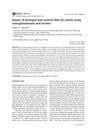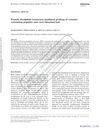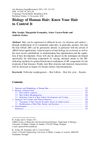TLDR Using enzymes to link proteins makes hair repair treatments more effective and long-lasting.
The study "Enzymatic Crosslinking of Amino Acids Improves the Repair Effect of Keratin on Hair Fibre" used hair samples from healthy Chinese adult women to test the effects of different repair solutions. The most effective solution was the Keratin-serine-enzyme repair solution (K-s-eRS), which increased the crystallinity of the hair by 37.20% and reduced alkali solubility by 50.53%. This solution forms a protective film that repairs damaged hair, improves its physical and chemical properties, and enhances its thermal stability. The hair becomes smoother, shinier, and healthier, with a reduced water loss rate. The study concludes that enzymatic crosslinking of amino acids significantly improves the repair effect of keratin on hair fibres, making it a promising approach for repairing damaged hair.
16 citations
,
October 2021 in “Trends in biotechnology” Future hair products will use ecofriendly proteins and peptides to improve hair health and appearance.
 3 citations
,
January 2021 in “ScienceAsia”
3 citations
,
January 2021 in “ScienceAsia” Using an enzyme and keratin treatment can significantly repair and strengthen damaged hair.
7 citations
,
September 2020 in “International Journal of Cosmetic Science” Different sizes of keratin peptides can strengthen hair, with smaller ones possibly increasing volume and larger ones repairing damage.
28 citations
,
January 2016 in “RSC Advances” A non-toxic formula using polycarboxylic acids strengthens and improves hair.
 28 citations
,
December 2011 in “Biocatalysis and biotransformation”
28 citations
,
December 2011 in “Biocatalysis and biotransformation” PDI helps restore over-bleached hair's strength and structure by attaching special peptides.
65 citations
,
May 2006 in “Journal of Structural Biology” Hair curliness is due to uneven distribution of different cortices within the hair fiber.
203 citations
,
June 2003 in “Journal of the American Academy of Dermatology” Human hair, despite its different types, shares common traits that affect its structure and response to treatments.

Human hair keratins can self-assemble and support cell growth, useful for biomedical applications.
 13 citations
,
January 2010 in “Advances in Biochemical Engineering / Biotechnology”
13 citations
,
January 2010 in “Advances in Biochemical Engineering / Biotechnology” Understanding hair biology is key to developing better treatments for hair and scalp issues.

Human hair keratins can be turned into useful 3D biomedical scaffolds through a freeze-thaw process.
 January 2024 in “Authorea (Authorea)”
January 2024 in “Authorea (Authorea)” Using laccase to add poly(tyrosine) to wool makes it less likely to shrink and stronger.
65 citations
,
March 2017 in “Experimental Dermatology” Curly hair is influenced by specific genetic variations.





